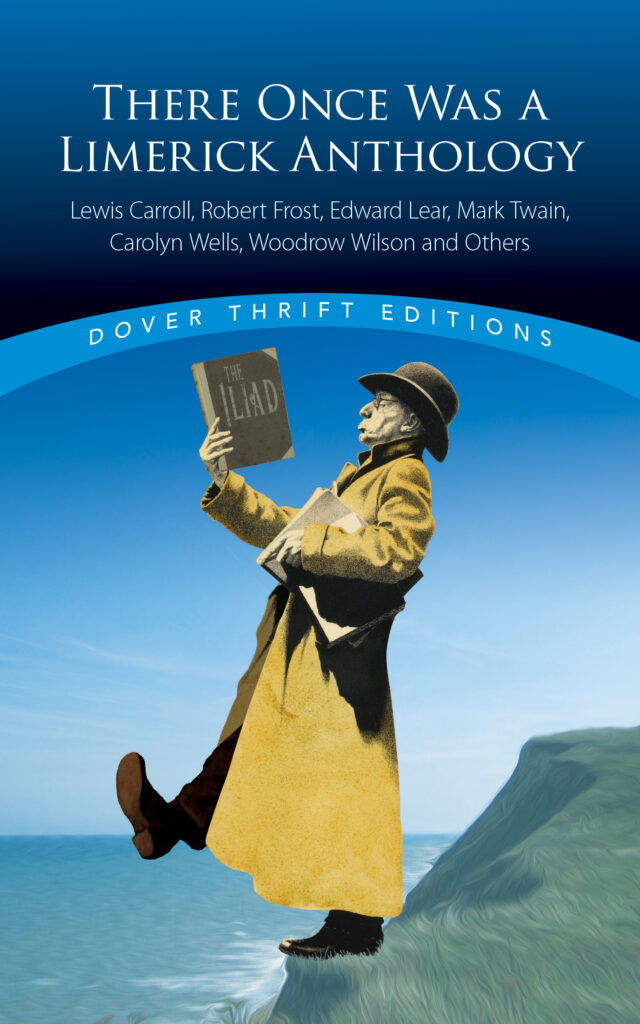In February, Post Hill Press published Rebecca Rego Barry’s The Vanishing of Carolyn Wells. It’s framed as “part biography” of author Carolyn Wells and “part sleuthing narrative” to discover and celebrate her legacy, despite far-flung documents and practical obstacles. Given the pivotal role that she has played in two of my anthologies, I elatedly devoured Wells’ first-ever biography.
* * *
In 2022, Dover Publications published my first poetry anthology, There Once Was a Limerick Anthology. Wells is tied with Edward Lear—”The Poet Laureate of the Limerick”—for the most limericks in the book. Five of her nine selections are in the “Tongue Twisters” chapter, where her talent is particularly pronounced. Since There Once Was a Limerick Anthology primarily features poems from the public domain—published no later than 1926—the phenomenal Carolyn Wells’ Book of American Limericks (1925) was an invaluable resource. As I noted in my introduction, Wells’s limerick anthology was one of three limerick books in the 1920s that formed the apex of the limerick’s golden age. Wells’s role in There Once Was a Limerick Anthology was so significant that she’s one of the half-dozen authors highlighted in the book’s subtitle.
In 2023, Dover published my Acrostic Poetry: The First-Ever Anthology. When I was assessing whether I could compile enough viable material for an undervalued poetic form, the “Acrostics” chapter in Wells’s A Whimsey Anthology (1906) pointed me in the right direction. It includes an acrostic by Sir John Davies, who began the tradition of using acrostics to praise someone’s name. It features acrostics by Lewis Carroll and Edgar Allan Poe, two of the three writers who get chapters to themselves in Acrostic Poetry. At some level, I appreciated that A Whimsey Anthology was one of several Wells anthologies that Dover had reprinted. Acrostic Poetry includes a droll alphabet poem by Wells, “A Christmas Alphabet.”
Following my limerick and acrostic anthologies, my take was that Wells was a leading figure in light verse, particularly in the years before the public domain cutoff. She was well regarded for her own verse and her anthologies. She’s no longer a household name, but she didn’t seem any more obscure than other key players in light verse from the same era.
* * *
My perspective was rather limited! The subtitle of The Vanishing of Carolyn Wells is “Investigations into a Forgotten Mystery Author.” In other words, Barry expounds, Wells (1862—1942) has been “lost” and underappreciated over time, and her primary genre was mystery. Barry offers a wellspring of fascinating information. Wells was the author or editor of a whopping 182 books—including 82 mystery novels—plus “countless poems, parodies, puzzles, short stories, and articles.” She more than dabbled in mystery, light verse, and children’s books, and Barry even shows “there is a case to be made” that the polyglot Wells was “the first New York Times crossword puzzle editor.” Following Wells’s 165th book in 1936, the Associated Press claimed that Wells “probably is the most prolific author in the world today,” who was on track to “establish a modern record that will stand for years to come.”
Barry gives considerable attention to Wells’ light verse. Poetry-loving President Theodore Roosevelt hailed Wells as “an expert in the matter of humorous verse.” Wells explained that nonsense verse “has got to be organic, well ordered, and, you might say, almost mathematical in its precision.” Barry cites scholarly studies by Margaret D. Stetz, who deemed Well’s comic writing “always brilliant and hilarious” but “neglected and understudied” in anthologies. My TBR list has certainly grown thanks to the citations in The Vanishing of Carolyn Wells!
According to Barry, A Whimsey Anthology was one of five Wells anthologies that were published between 1902 and 1907 and “functioned as a set of uniformly designed and packaged volumes.” In 1906, The New York Times heralded, “Anthologies before Carolyn Wells took to making them were grave and formidable things. Her Satire Anthology, Parody Anthology, and Nonsense Anthology changed all that.” Barry notes that “[o]ther anthologies and collections would follow” later in Wells’s career, but Carolyn Wells’s Book of American Limericks only comes up in passing in the biography, seemingly lost in the lost writer’s vast oeuvre.
While Wells’s works might have fallen out of favor, Barry proves that she was revered, even if not consistently for all 182 books, during her lifetime. In 1902, The Evansville Courier declared, “It is doubtful if any living writer possessed a greater charm of style and a more exquisite sense of humor than Miss Wells and her books are eagerly sought in every community.” In 1925, the Warren Tribune said, “It would be perfectly reasonable for Carolyn Wells to claim the title of all-around literary champion of America, if not of the world . . . . Her versatility has been equalled only by her industry, and she has been successful in all the fields that she has entered.”
* * *
I highly recommend The Vanishing of Carolyn Wells. I’ve never enjoyed footnotes as much as I did with Barry’s whimsical asides. Wells’s role in shaping the mystery genre is notable. The final chapter, outlining how Wells became lost to history, is savvy and gripping. Wells was deaf, and it’s even more impressive that she accomplished so much despite the challenges this posed. She was an avid book collector, including of the aforementioned Lear, Carroll, and Poe, who, together with Wells, were shining stars in my limerick and acrostic anthologies. I’m thrilled that Wells got her long overdue, much deserved turn in the spotlight.



No Comments